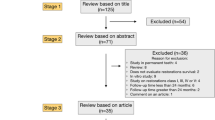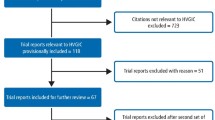Abstract
Objective To compare the survival of direct resin-composite used as onlays and indirect tooth-coloured adhesive onlays in posterior teeth, along with modes of failure, deterioration and variables affecting survival.
Materials and methods PubMed, Embase, The Cochrane Library, Web of Science and Scopus were searched systematically up to 16 October 2020. In total, 3,768 studies were screened, with their results for survival, failure mode, deterioration and variables affecting survival.
Results In total, 30 studies were selected. Survival rates in included studies greater than three years in length were 73.1-100%, with a median survival of 92.5% and median follow-up length of 5.1 years. The most prevalent failure mode was fracture, followed by pulpal episodes, debonding and caries. The most prevalent deterioration criteria were loss of marginal integrity and discolouration.
Conclusions Survival of direct resin composite onlays and indirect tooth-coloured adhesive onlays in posterior teeth is acceptable (73.1-100%) in the medium-term. There is a need for more studies on direct cusp covering resin composite restorations, zirconia onlays and studies comparing material types. Fracture was the most prevalent failure mode. Restoration margins were the most prevalent area of deterioration.
Clinical significance Direct and indirect tooth-coloured adhesive onlays can be a reliable and more conservative way to restore posterior teeth across a range of material options.
Key points
-
Demonstrates the longevity of indirect ceramic onlays.
-
Demonstrates the limited studies on the acceptable longevity of direct tooth-coloured onlays.
-
Shows bulk fracture as the most likely failure mechanism and margins as the most common deterioration site.
This is a preview of subscription content, access via your institution
Access options
Subscribe to this journal
Receive 24 print issues and online access
$259.00 per year
only $10.79 per issue
Buy this article
- Purchase on Springer Link
- Instant access to full article PDF
Prices may be subject to local taxes which are calculated during checkout

Similar content being viewed by others
References
Sequeira-Byron P, Fedorowicz Z, Carter B, Nasser M, Alrowaili E F. Single crowns versus conventional fillings for the restoration of root-filled teeth. Cochrane Database Syst Rev 2015; DOI: 10.1002/14651858.CD009109.pub3.
The Academy of Prosthodontics. The Glossary of Prosthodontic Terms: Ninth Edition. J Prosthet Dent 2017; DOI: 10.1016/j.prosdent.2016.12.001.
Wassell R W, Walls A W, McCabe J F. Direct composite inlays versus conventional composite restorations: 5-year follow-up. J Dent 2000; 28: 375-382.
Luciano M, Francesca Z, Michela S, Tommaso M, Massimo A. Lithium disilicate posterior overlays: clinical and biomechanical features. Clin Oral Investig 2020; 24: 841-848.
Morimoto S, Rebello de Sampaio F B, Braga M M, Sesma N, Ozcan M. Survival Rate of Resin and Ceramic Inlays, Onlays, and Overlays: A Systematic Review and Meta-analysis. J Dent Res 2016; 95: 985-994.
Kelly P G, Smales R J. Long-term cost-effectiveness of single indirect restorations in selected dental practices. Br Dent J 2004; 196: 639-643.
Angeletaki F, Gkogkos A, Papazoglou E, Kloukos D. Direct versus indirect inlay/onlay composite restorations in posterior teeth. A systematic review and meta-analysis. J Dent 2016; 53: 12-21.
Burke F J T, Lucarotti P S K. The ultimate guide to restoration longevity in England and Wales. Part 10: key findings from a ten million restoration dataset. Br Dent J 2018; 225: 1011-1018.
British Society for Restorative Dentistry. Crowns, Fixed Bridge and Dental Implant Guidelines. 2013. Available at https://www.bsrd.org.uk/File.ashx?id=15191 (accessed June 2022).
Ibbetson R, Jones I R. All-Ceramic inlays and onlays for posterior teeth. Dent Update 2019; 46: 620-624.
Anusavice K J. Criteria for placement and replacement of dental restorations. Fla Dent J 1988; 59: 30-31.
Mjör I A, Jokstad A, Qvist V. Longevity of posterior restorations. Int Dent J 1990; 40: 11-17.
Mondelli R F L, Ishikiriama S K, de Oliveira Filho O, Mondelli J. Fracture resistance of weakened teeth restored with condensable resin with and without cusp coverage. J Appl Oral Sci 2009; 17: 161-165.
Kim K-L, Namgung C, Cho B-H. The effect of clinical performance on the survival estimates of direct restorations. Restor Dent Endod 2013; 38: 11-20.
Abduo J, Sambrook R J. Longevity of ceramic onlays: A systematic review. J Esthet Restor Dent 2018; 30: 193-215.
Page M J, McKenzie J E, Bossuyt P M et al. The PRISMA 2020 statement: an updated guideline for reporting systematic reviews. BMJ 2021; DOI: 10.1136/bmj.n71.
Cochrane Training. Cochrane Handbook for Systematic Reviews of Interventions. 2022. Available at https://training.cochrane.org/handbook (accessed June 2022).
Sterne J A C, Savović J, Page M J et al. RoB 2: a revised tool for assessing risk of bias in randomised trials. BMJ 2019; DOI: 10.1136/bmj.l4898.
Sterne J A, Hernán M A, Reeves B C et al. ROBINS-I: a tool for assessing risk of bias in non-randomised studies of interventions. BMJ 2016; DOI: 10.1136/bmj.i4919.
Archibald J J, Santos G C Jr, Moraes Coelho Santos M J. Retrospective clinical evaluation of ceramic onlays placed by dental students. J Prosthet Dent 2018; 119: 743-748.
Guess P C, Selz C F, Steinhart Y-N, Stampf S, Strub J R. Prospective clinical split-mouth study of pressed and CAD/CAM all-ceramic partial-coverage restorations: 7-year results. Int J Prosthodont 2013; 26: 21-25.
Edelhoff D, Güth J F, Erdelt K, Brix O, Liebermann A. Clinical performance of occlusal onlays made of lithium disilicate ceramic in patients with severe tooth wear up to 11 years. Dent Mater 2019; 35: 1319-1330.
Malament K A, Margvelashvili-Malament M, Natto Z S, Thompson V, Rekow D, Att W. 10.9-year survival of pressed acid etched monolithic e.max lithium disilicate glass-ceramic partial coverage restorations: Performance and outcomes as a function of tooth position, age, sex, and the type of partial coverage restoration (inlay or onlay). J Prosthet Dent 2021; 126: 523-532.
Fasbinder D J, Neiva G F, Heys D, Heys R. Clinical evaluation of chairside Computer Assisted Design/Computer Assisted Machining nano-ceramic restorations: Five-year status. J Esthet Restor Dent 2020; 32: 193-203.
Bühler J, Naef M A, Amato M, Krastl G, Weiger R, Zitzmann N U. Partial Ceramic Crowns Prepared by Dental Students: Clinical Performance Up to Five Years. J Dent Educ 2017; 81: 732-743.
Nejatidanesh F, Amjadi M, Akouchekian M, Savabi O. Clinical performance of CEREC AC Bluecam conservative ceramic restorations after five years - A retrospective study. J Dent 2015; 43: 1076-1082.
Ozyoney G, Yan Koğlu F, Tağtekin D, Hayran O. The efficacy of glass-ceramic onlays in the restoration of morphologically compromised and endodontically treated molars. Int J Prosthodont 2013; 26: 230-234.
van Dijken J W V, Hasselrot L. A prospective 15-year evaluation of extensive dentin-enamel-bonded pressed ceramic coverages. Dent Mater 2010; 26: 929-939.
Naeselius K, Arnelund C-F, Molin M K. Clinical evaluation of all-ceramic onlays: a 4-year retrospective study. Int J Prosthodont 2008; 21: 40-44.
Galiatsatos A A, Bergou D. Six-year clinical evaluation of ceramic inlays and onlays. Quintessence Int 2008; 39: 407-412.
Arnelund C-F, Johansson A, Ericson M, Häger P, Fyrberg K A. Five-year evaluation of two resin-retained ceramic systems: a retrospective study in a general practice setting. Int J Prosthodont 2004; 17: 302-306.
Barghi N, Berry T G. Clinical evaluation of etched porcelain onlays: a 4-year report. Compend Contin Educ Dent 2002; 23: 657-660.
Felden A, Schmalz G, Hiller K A. Retrospective clinical study and survival analysis on partial ceramic crowns: results up to 7 years. Clin Oral Investig 2000; 4: 199-205.
Lehner C, Studer S, Brodbeck U, Schärer P. Six-Year Clinical Results of Leucite-Reinforced Glass Ceramic Inlays and Onlays. Acta Med Dent Helv 1998; 3: 218-225.
Borgia Botto E, Baró R, Borgia Botto J L. Clinical performance of bonded ceramic inlays/onlays: A 5-to 18-year retrospective longitudinal study. Am J Dent 2016; 29: 187-192.
Strasding M, Sebestyén-Hüvös E, Studer S, Lehner C, Jung R E, Sailer I. Long-term outcomes of all-ceramic inlays and onlays after a mean observation time of 11 years. Quintessence Int 2020; 51: 566-576.
Baader K, Hiller K-A, Buchalla W, Schmalz G, Federlin M. Self-adhesive Luting of Partial Ceramic Crowns: Selective Enamel Etching Leads to Higher Survival after 6.5 Years In Vivo. J Adhes Dent 2016; 18: 69-79.
Arnetzl G V, Arnetzl G. Reliability of nonretentive all-ceramic CAD/CAM overlays. Int J Comput Dent 2012; 15: 185-197.
Beier U S, Kapferer I, Burtscher D, Giesinger J M, Dumfahrt H. Clinical performance of all-ceramic inlay and onlay restorations in posterior teeth. Int J Prosthodont 2012; 25: 395-402.
Roggendorf M J, Kunzi B, Ebert J, Roggendorf H C, Frankenberger R, Reich S M. Seven-year clinical performance of CEREC-2 all-ceramic CAD/CAM restorations placed within deeply destroyed teeth. Clin Oral Investig 2012; 16: 1413-1424.
Federlin M, Hiller K A, Schmalz G. Controlled, prospective clinical split-mouth study of cast gold vs. ceramic partial crowns: 5.5 year results. Am J Dent 2010; 23: 161-167.
Smales R J, Etemadi S. Survival of ceramic onlays placed with and without metal reinforcement. J Prosthet Dent 2004; 91: 548-553.
Dietschi D, Spreafico R. Evidence-based concepts and procedures for bonded inlays and onlays. Part III. A case series with long-term clinical results and follow-up. Int J Esthet Dent 2019; 14: 118-133.
Chrepa V, Konstantinidis I, Kotsakis G A, Mitsias M E. The survival of indirect composite resin onlays for the restoration of root filled teeth: a retrospective medium-term study. Int Endod J 2014; 47: 967-973.
Fennis W M, Kuijs R H, Roeters F J, Creugers N H, Kreulen C M. Randomized control trial of composite cuspal restorations: five-year results. J Dent Res 2014; 93: 36-41.
D'Arcangelo C, Zarow M, De Angelis F et al. Five-year retrospective clinical study of indirect composite restorations luted with a light-cured composite in posterior teeth. Clin Oral Investig 2014; 18: 615-624.
Signore A, Benedicenti S, Covani U, Ravera G. A 4-to 6-year retrospective clinical study of cracked teeth restored with bonded indirect resin composite onlays. Int J Prosthodont 2007; 20: 609-616.
Leirskar J, Nordbø H, Thoresen N R, Henaug T, von der Fehr F R. A four to six years follow-up of indirect resin composite inlays/onlays. Acta Odontol Scand 2003; 61: 247-251.
Attin T, Filli T, Imfeld C, Schmidlin P R. Composite vertical bite reconstructions in eroded dentitions after 5·5 years: a case series. J Oral Rehabil 2012; 39: 73-79.
Cvar J F, Ryge G. Criteria for the Clinical Evaluation of Dental Restorative Materials. California: US Department of Health, Education and Welfare, 1971.
California Dental Association. Quality Evaluation for Dental Care: Guidelines for Assessment of Clinical Quality and Professional Performance. California: California Dental Association, 1977.
von Maltzahn N F, El Meniawy O I, Breitenbuecher N, Kohorst P, Stiesch M, Eisenburger M. Fracture Strength of Ceramic Posterior Occlusal Veneers for Functional Rehabilitation of an Abrasive Dentition. Int J Prosthodont 2018; 31: 451-452.
Fron Chabouis H, Smail Faugeron V, Attal J-P. Clinical efficacy of composite versus ceramic inlays and onlays: a systematic review. Dent Mater 2013; 29: 1209-1218.
Derchi G, Marchio V, Borgia V, Özcan M, Giuca M R, Barone A. Twelve-year longitudinal clinical evaluation of bonded indirect composite resin inlays. Quintessence Int 2019; 50: 448-454.
Reiss B. Clinical results of Cerec inlays in a dental practice over a period of 18 years. Int J Comput Dent 2006; 9: 11-22.
Otto T. Up to 27-years clinical long-term results of chairside Cerec 1 CAD/CAM inlays and onlays. Int J Comput Dent 2017; 20: 315-329.
Dejak B, Mlotkowski A, Romanowicz M. Strength estimation of different designs of ceramic inlays and onlays in molars based on the Tsai-Wu failure criterion. J Prosthet Dent 2007; 98: 89-100.
Xie K X, Wang X Y, Gao X J, Yuan C Y, Li J X, Chu C H. Fracture resistance of root filled premolar teeth restored with direct composite resin with or without cusp coverage. Int Endod J 2012; 45: 524-529.
Salehrabi R, Rotstein I. Endodontic treatment outcomes in a large patient population in the USA: an epidemiological study. J Endod 2004; 30: 846-850.
Ng Y-L, Mann V, Gulabivala K. A prospective study of the factors affecting outcomes of non-surgical root canal treatment: part 2: tooth survival. Int Endod J 2011; 44: 610-625.
Pallesen U, Qvist V. Composite resin fillings and inlays. An 11-year evaluation. Clin Oral Investig 2003; 7: 71-79.
Wassell R, Nohl F, Steele J, Walls A. Extra-Coronal Restorations: Concepts and clinical application. 2nd ed. New York: Springer, 2018.
Shafiei F, Memarpour M, Karimi F. Fracture resistance of cuspal coverage of endodontically treated maxillary premolars with combined composite-amalgam compared to other techniques. Oper Dent 2011; 36: 439-447.
Borgia E, Baron R, Borgia J L. Quality and Survival of Direct Light-Activated Composite Resin Restorations in Posterior Teeth: A 5-to 20-Year Retrospective Longitudinal Study. J Prosthodont 2019; DOI: 10.1111/jopr.12630.
Opdam N J M, van de Sande F H, Bronkhorst E et al. Longevity of posterior composite restorations: a systematic review and meta-analysis. J Dent Res 2014; 93: 943-949.
Magne P, Boff L L, Oderich E, Cardoso A C. Computer-aided-design/computer-assisted-manufactured adhesive restoration of molars with a compromised cusp: effect of fibre-reinforced immediate dentin sealing and cusp overlap on fatigue strength. J Esthet Restor Dent 2012; 24: 135-146.
Fennis W M M, Kuijs R H, Kreulen C M, Verdonschot N, Creugers N H J. Fatigue resistance of teeth restored with cuspal-coverage composite restorations. Int J Prosthodont 2004; 17: 313-317.
El-Mowafy O, Brochu J-F. Longevity and clinical performance of IPS-Empress ceramic restorations-a literature review. J Can Dent Assoc 2002; 68: 233-237.
Pieger S, Salman A, Bidra A S. Clinical outcomes of lithium disilicate single crowns and partial fixed dental prostheses: a systematic review. J Prosthet Dent 2014; 112: 22-30.
Fleming G J P, Addison O. Adhesive Cementation and the Strengthening of All-Ceramic Dental Restorations. J Adhes Sci Tech 2009; 23: 945-959.
Shillingburg H. The Fundamentals of Fixed Prosthodontics. 4th ed. Illinois: Quintessence, 2012.
Chana H, Kelleher M, Briggs P, Hooper R. Clinical evaluation of resin-bonded gold alloy veneers. J Prosthet Dent 2000; 83: 294-300.
Bandlish L K, Mariatos G. Long-term survivals of 'direct-wax' cast gold onlays: a retrospective study in a general dental practice. Br Dent J 2009 8; 207: 111-115.
Funding
The work was supported by the authors. The authors do not have any financial interest in the companies whose materials are included in this article.
Author information
Authors and Affiliations
Contributions
Colin E. McGrath was main author and researcher (of this MSc project). Stephen J. Bonsor was McGrath's tutor, mentor and adviser, completing proofreading and search checking.
Corresponding author
Ethics declarations
There are no conflicts of interest involved in this article. No ethical approval was sought as this review did not involve any humans or animals.
Supplementary Information
Rights and permissions
About this article
Cite this article
McGrath, C., Bonsor, S. Survival of direct resin composite onlays and indirect tooth-coloured adhesive onlays in posterior teeth: a systematic review. Br Dent J (2022). https://doi.org/10.1038/s41415-022-4395-3
Received:
Accepted:
Published:
DOI: https://doi.org/10.1038/s41415-022-4395-3



